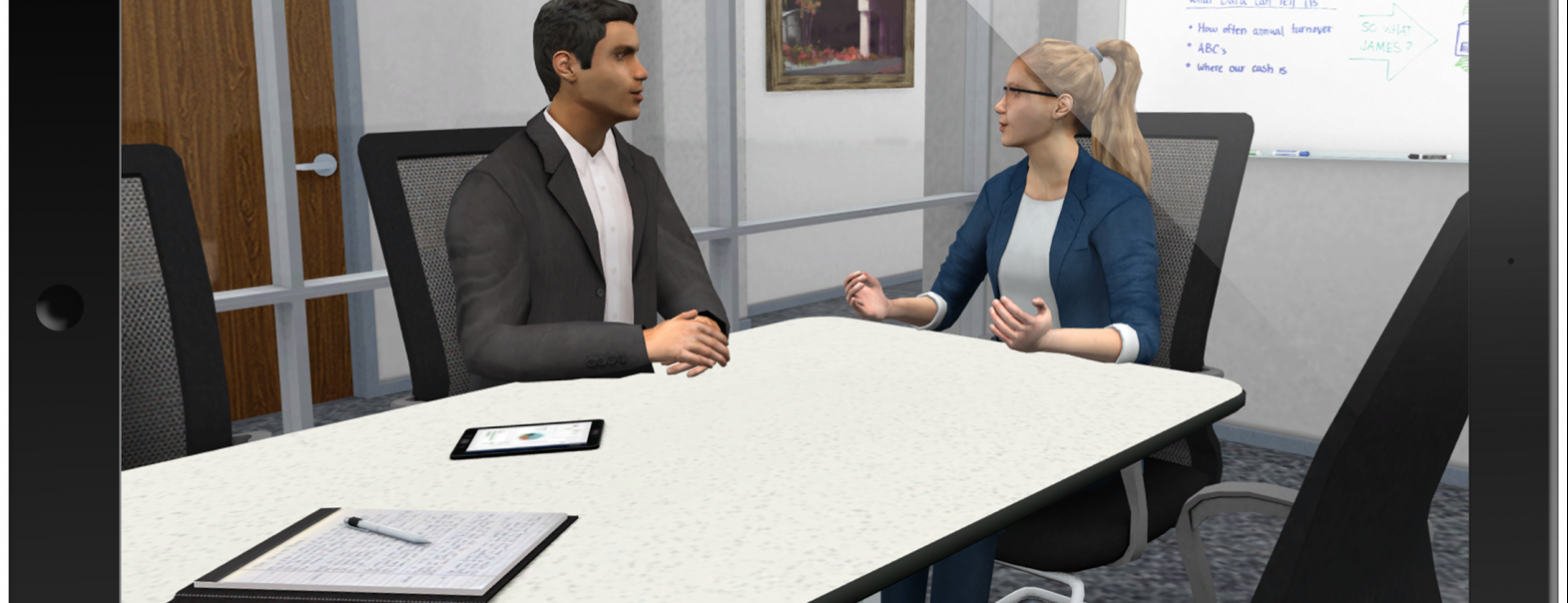
Articles
Editor’s Picks
Interviews
Syandus CEO Douglas Seifert Discusses Corporate Training with 3D Virtual Environments
By Henry Kronk
April 08, 2019
There’s no shortage today of companies translating digital technology and game-based learning into corporate training solutions. But when Syandus opened shop 15 years ago, that was not the case. Via their AliveSim platform, they create custom corporate training modules, typically revolving around decision-making skills. eLearning Inside reached CEO Douglas Seifert to learn about how they started coopting video game-style simulations for corporate training in the first place.
Henry Kronk: How did you start out?
Douglas Seifert: It all started way back about 15 years ago when I was involved in scaling up vaccine processes. The associated immunology is complex and not easy to understand. At the time there was this game technology out there in the entertainment sector that’s very powerful and immersive. I thought, if one could integrate that with the cognitive science of learning, one could create a powerful educational medium to help learn difficult concepts.
That’s where Syandus started. This was very new at the time. We received a Small Business Innovation and Research (SBIR) award from the National Science Foundation (NSF). We used that to start our research. We’ve now received 8 of these SBIR awards and they’ve allowed us to build this platform.
Syandus Branches Out
HK: How did Syandus expand over time?
DS: We originally were using it to educate many thousands of doctors in medical education, helping them understand differential diagnosis and optimal treatment pathways. We were immersing them in these realistic clinical situations and the science of disease.
The NSF has this SBIR bootcamp program where they’re help entrepreneurs think about how to best develop technology for your customers, etc. They challenged us to think reach outside of what we were doing in medicine and science. That’s how we started thinking about corporate training as a great fit for what we’re doing. We did our market research and talked to lot of companies out there. It turned out that there was a significant need on the corporate training side. So, we expanded and transitioned our platform accordingly.
HK: Bring me through the process of onboarding a new client.
DS: Usually the ideal customer fit for what we do is a company that has training for an existing business process. For example, it could be a leadership coaching process or a sales training process. The customer challenge is that after the training is done, the knowledge recedes, and it doesn’t really pull through or change behaviors in the work place. That gap is what we fill by creating virtual practice with personalized coaching.
What we’re doing is creating virtual, realistic situations based on their process, where their learners can go in, make decisions, interact with virtual humans, and receive personalized feedback. The way it’s designed, learners start recognizing the optimal decision paths that the top performers in the company are already using. Customers can then scale the program across their organization and allow their employees to experience this virtual practice. This approach maximizes their training investment: Training does not recede, instead the practice can pull it through and change behaviors in the workplace.
Selecting a Video-Game Style 3D Environment as the Ideal Modality
HK: Virtual training has been around for some time, but conducting it via virtual environments, that has come about relatively recently. When you were first starting out, why did you choose this modality as the best way to deliver this training?
DS: Our thinking process started with ‘how do we create the best situation in which to learn?’ It would likely be to interact with a mentor. A mentor challenges you with what to do in various situations, you respond, and then they provide insightful feedback and coaching. Doing it one-on-one is a scale issue. That’s the main challenge that companies have.
We then asked, ‘How can we do this digitally?’ From a cognitive science standpoint, you want it to be experiential and really immersive (not passive, like a video). You want it to be very engaging. When you think about which technologies you could choose, game technology has a great fit there. It’s certainly immersive and very responsive. What we also discovered is what is called ‘the game loop.’ 60 times a second, the game code goes through a loop where it’s taking inputs from the user and built in artificial intelligence and algorithms to decide how it’s going to respond, and then it updates the screen and triggers sound output.
When you think about that from a learning perspective, it’s fantastic. It’s like a learning engine. You have set up a situation where the learner is making decisions in real time with virtual humans responding to the learner in context.
A disadvantage early on with game technology was that it wouldn’t run on all computers. Our biggest question starting out was, ‘do users have graphics cards that can run 3D environments?’ That was a real challenge. Now, we can run these game environments on any device, including a phone. And because it runs through a web browser, we can offer customer access via an economical SaaS model.
So, game technology seemed like a natural fit from a learning standpoint, from a technology standpoint, and from a delivery standpoint. And this approach can also provide rich analytics on the back end—you can measure everything.
HK: There are a lot of virtual and digital corporate training solutions these days coming out using emerging technology like augmented reality (AR) and virtual reality (VR). I understand that Syandus does not employ these. Could you tell me more about the decision-making process behind that choice?
DS: We have done some research here on VR. Our developers are actually excited about this technology. We had to look at it from the standpoint of learning objectives. We ask: ‘What are the learning objectives? And what technology fits best for them?’ These questions drive what is the most appropriate investment.
When you look at VR, the power of VR, is emulating a physical environment where you can look around. Therefore, the learning objective should involve interacting with the physical environment. For example, in manufacturing, construction, safety, first responders, etc.. In these training situations, that’s where you really want to invest in VR. It’s going to be exciting and immersive, but you have to invest in a headset and all that technology.
Because we’re focused on conversations, VR was not the right fit for us. We work through business processes involving sales, leadership, and other challenging situations that involve conversation. There, turning around and seeing behind you doesn’t really matter. It doesn’t really help to invest in VR technology for that. For us, the best fit was to develop technology that could be used on any screen and any device. That’s a challenge in itself.
The Future of Game-Based Corporate Training
HK: I want to touch on virtual learning as a market in and of itself. It seems from what you’ve told me, your base tends to be companies that are established and growing. Options for corporate training like this, they’re only increasing. With a lot of new technology, as things become more developed, costs drop, and they become more viable for more customers. How far do you think that’s going to go with corporate training?
DS: That’s a great question, and I think there are several different ways to approach it. Right now, many immersive technology companies are completely custom —this is the way we started as well. You start with a blank sheet of paper and the developers say: ‘we can do anything for you.’ When you do that, it’s very costly and it takes a lot of time. These situations do not lend themselves to anyone doing it—it’s only for big budgets.
What we have done is ask ourselves, ‘of all this custom work we’ve done, what really works? What is really needed?’ We have focused on that. We realized very early on that you need these 3D environments, but walking around in them doesn’t really help with the type of learning we’re doing. So we limited that functionality and focused on the parts of the environment that furthered our learning objectives -like conversations with virtual humans.
By creating a platform that does specific things well, you can lower the cost significantly. Aligning the scope of the program with what the platform can deliver, makes delivery in a more cost-effective way possible. That’s our focus.
If you do want or need a custom solution that’s not one-size-fits-all, then there has to be a way to very quickly and economically build these options for every company. We’ve been working on doing just that. We facilitate custom content development in our platform now. Down the road (it will be out next year), we’ll enable our customers to edit their own content within our platform. Eventually, they’ll be able to build their own 3D virtual training environments within the platform. That’s really exciting.
Media Courtesy of Syandus.









No Comments